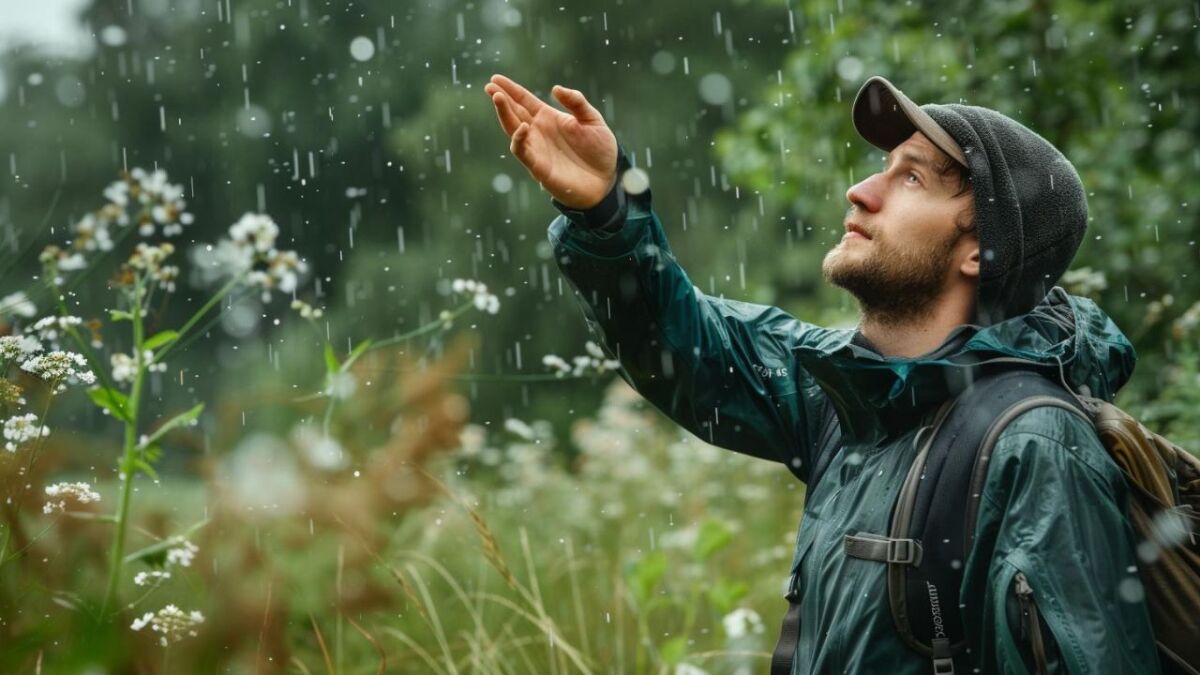
Weather forecast with animals, plants or clouds - assessing the weather through observation of nature
👉 The key facts from this guide
- Discover the art of weather prediction without technology by relying on ancient knowledge and observation skills.
- Learn how sailors and farmers predicted the weather using clouds and wind directions.
- Understand how air pressure and humidity can provide clues about upcoming weather changes.
- Observe animals and plants to infer from their reactions to the weather.
- Create your own weather journal to identify patterns and strengthen your prediction skills.
- Build a natural weather station to measure and interpret the weather using simple means.
Do you know the feeling of standing in the middle of nature and observing the sky, hoping to predict the weather?
You see clouds passing by, feel the wind, and wonder if you will soon get caught in a rain shower.
You stand there, at the mercy of the elements, without really knowing what Mother Nature has in store for you.
Fact is: the art of prediction is an underestimated skill.
State-of-the-art technology is a great thing, but not always readily available or reliable in the wilderness.
And there they are: The days when you only have your instinct, far away from any prediction.
With over many years of experience as an outdoor enthusiast and numerous completed survival trainings, I will show you how to read and predict the weather without weather apps and high-tech devices.
Use ancient knowledge and observational skills to become an expert in natural phenomena and navigate safely through the landscape.
Are you ready to learn the skills that nature presents as an open book? Let's begin our journey into the world of weather reading.
A little journey back in time to the roots of weather forecasting
Let's take a journey back in time, long before we had satellite images and weather apps. We start where weather reading was still essential for survival.
Secrets of the Clouds: Discovering Historical Wisdom
Imagine you are a sailor, centuries ago, your eyes fixed on the horizon and the sky. Every breeze could bring news of an impending change.
Sailors and farmers have long known that fiery red sunsets indicate good weather, while a red morning sky often heralds bad weather.
"Evening red, good weather ahead, morning red threatens rain."
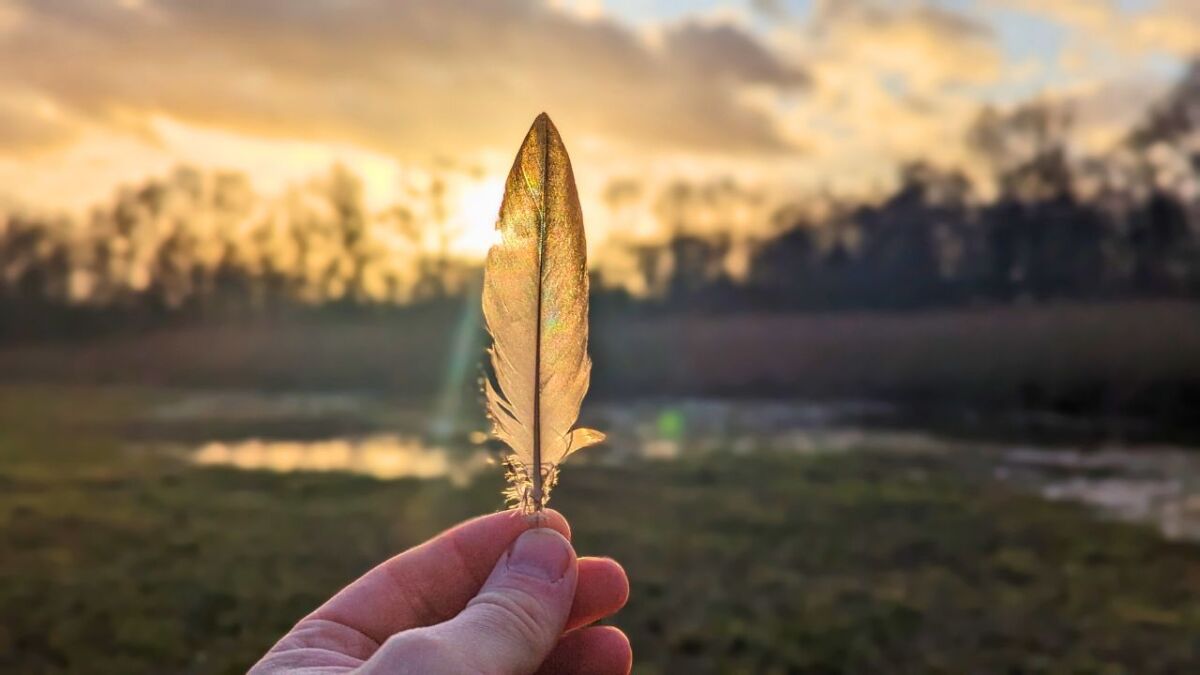
👉 When the sky is red in the evening, it means something special. It indicates that the air in the west is clear. Why is that? Because as the sun sets, it shines through more atmosphere. This causes the light to scatter. The red wavelengths in particular scatter strongly. This suggests that good weather is approaching from the west.
👉 A red sky in the morning towards the east, however, can indicate that the clear air has moved further east and may be followed by a trough of low pressure with rain clouds from the west.
Wonderful, we have already learned the first weather proverb! 🤜 🤛
Voices of the Earth: Traditional Knowledge of Indigenous Peoples for Prediction
Indigenous peoples understood the art of weather reading like no other.
Nature was her teacher, her compass, her calendar.
In Australia, for example, the Aborigines were able to infer the onset of the rainy season through the blooming of certain plants.
Birds, insects, and the wind told them about changes. This knowledge was passed down from generation to generation, a precious treasure of wisdom.
Today we use high-tech weather stations, satellites, and super-accurate models to analyze the weather. We have an abundance of data, but sometimes it makes us feel overwhelmed and disconnected from nature.

Without technology to the weather professional?
You won't believe it, but yes, it is possible!
It's not about magic, but about the combination of observation, experience, and intuition.
And that's exactly what makes the difference between just being outside and having a real outdoor experience.
Let's dive deeper into the topic and find out how you can become safer with every step you take in the wilderness.
Between Instinct and Algorithm: The Best of Both Worlds
The greatest art lies in not forgetting traditional knowledge while using modern tools.
While a smartphone can give you a prediction, knowing about cloud formations and natural phenomena allows you to make your own prediction - deeply rooted in the surrounding reality.
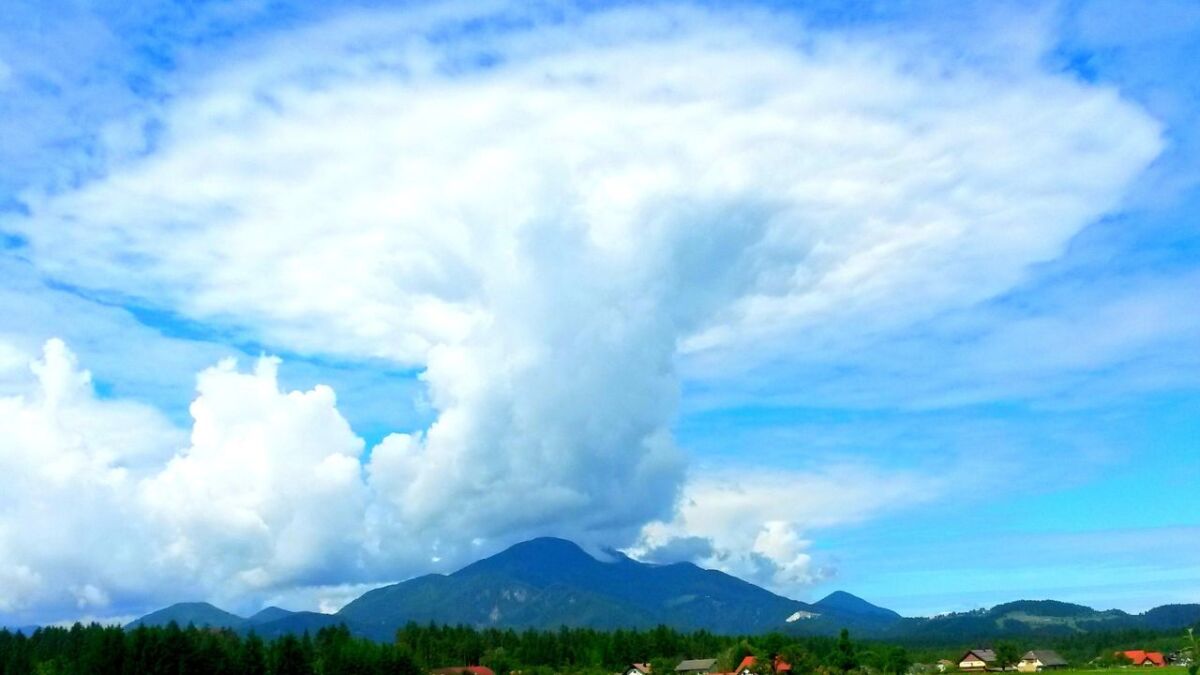
Imagine combining ancient wisdom with modern technology. You will see the world through different eyes.
You are connected - to the past and the present, to technology and nature. That's what true mastery in the art of weather forecasting is all about.
Let's refresh these skills and explore together how we can make this incredible knowledge our own. Ready?
Weather forecast through nature observation
Take a moment and let's leave behind the convenience of digital tools.
Imagine diving deep into the world as it used to be - a world where the answers are written in the sky and animal behavior often speaks louder than any weather app.
That's exactly what I wanted to know. I wanted to know how natural weather forecasting works. So I learned old weather sayings, asked wilderness mentors, researched, and read.
The concentrated load of insights is coming now.
Air pressure, humidity, wind, and sky: The invisible helpers
You don't have to complete a meteorology degree to understand the weather.
Instead, start with these natural indicators of weather changes:
- Air pressure
- Humidity
- Wind behavior
- Clouds
- Animals
- Plants
Soon you will understand that every small change, every twitch of the leaves, has a meaning. And the best part: It costs you nothing, except a little attention.
1. Sensing air pressure - Nature's barometer for tomorrow's weather
The air pressure is like an invisible hand that controls the weather.
He is a key indicator of how the weather will develop, and a little knowledge about it can help you better prepare for upcoming changes.
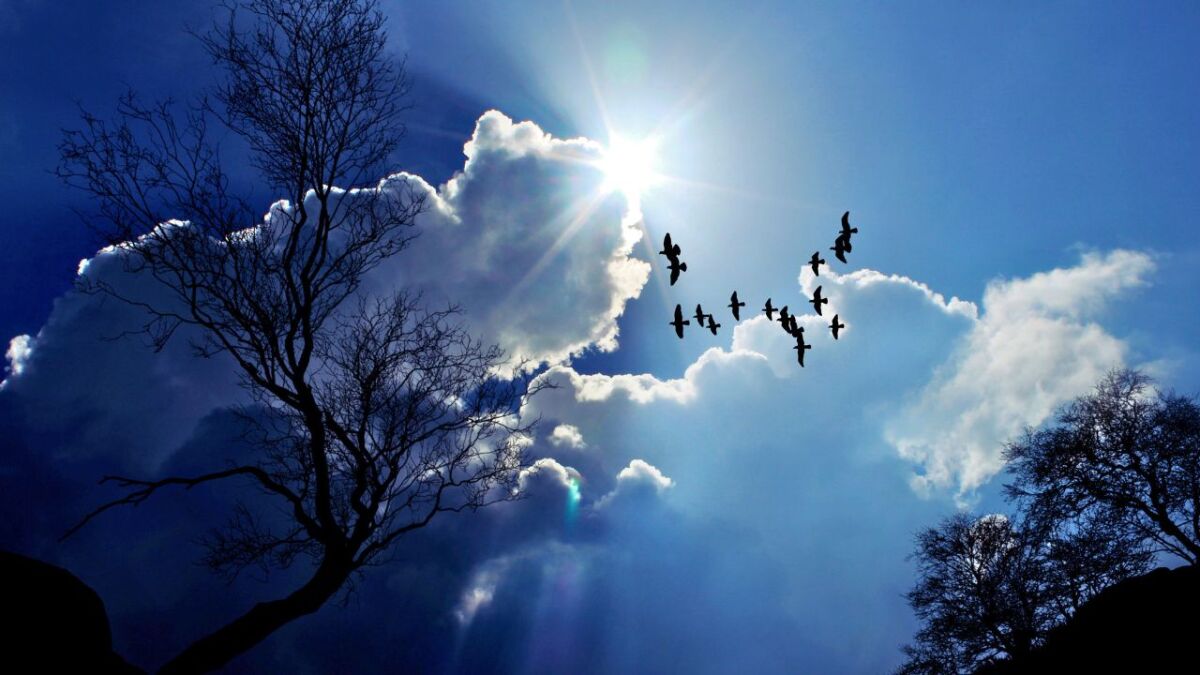
Decreasing air pressure
- A falling air pressure often indicates a deterioration in the weather. There are some signs you can observe outside:
- Changes in the sky: Clouds form more quickly and become denser. Look out for increasing cloud cover and darker cloud formations.
- Animal behavior: Birds fly lower and animals seek shelter. Their instinct tells them that bad weather is approaching.
- Physical reactions: Some people feel a pressure in their head or notice that their joints are more sensitive, both of which can indicate a drop in air pressure.
Rising air pressure
- In contrast, a rising air pressure indicates an improvement in the weather. Here are some signs you can notice:
- Clearing sky: The sky clears up, and the sun appears more frequently. Clouds dissipate or are less dense.
- Calm animal behavior: Animals behave more relaxed and are more active, birds sing more, indicating good weather.
- Physical well-being: An increase in air pressure can make you feel physically better, especially if you are sensitive to weather changes.
No barometer at hand? No problem! Use water and a few simple materials to create your own air pressure gauge. Even a simple glass of water can tell you what the air pressure is doing - if bubbles rise quickly, the weather may be changing.
2. Humidity as the Whisper of the Atmosphere
Humidity - an inconspicuous but meaningful indicator. It tells stories of impending fog, dew, and rain.
- If the leaves are heavy with dew in the morning, the humidity is high.
- Look at the spider webs: If they are wet, the nighttime humidity has spoken.

And if your skin feels sticky or you feel like the air is thick enough to cut, these are indications of high humidity.
This is often a harbinger of sultry days and stormy developments. Listen to this gentle whisper - it will reveal more to you than you think.
3. Winds that tell stories
Wind rarely comes without a message. Here are my observations:
- North wind: Brings coolness.
- South wind: Can bring warmth and sometimes a burst of rain.
- East wind: Often brings cold spells.
- West wind: Indication of unsettled weather.
Additional indicators:
- Feel the wind direction on your wet finger.
- Watch how smoke rises from your campfire. Rising smoke means good weather.

Not only the First Nations of North America knew the art of determining the wind direction without a compass. Whether it's the damp grass in the morning that tells you the direction of the night wind, or the tried and true method of holding moist fingers in the air - nature gives you all the information you need.
Wind will tell you more than a thousand words. Learn to feel its direction and strength.
The wind tells you about upcoming fronts, warm or cold air intrusions. A reliable ally that helps you turn the page on the weather chapter and anticipate what will be written next.
4. Interpreting clouds to make predictions
A clear, deep blue sky usually promises stable weather, while a pale shimmer on the horizon can indicate bad weather.
Have you ever looked up at the clouds and tried to see shapes?
Now let's go into detail. Cumulus, Stratus, Cirrus - these cloud formations are your new best friends. Understanding them will give you insights.
A fluffy cumulus cloud can mean it's time for a picnic, while a menacing cumulonimbus tells you that you better waterproof your tent.
But the sky tells much more when you learn to understand the language of clouds. Here are the most important cloud formations:
| Image of cloud type | Cloud type | Meaning |
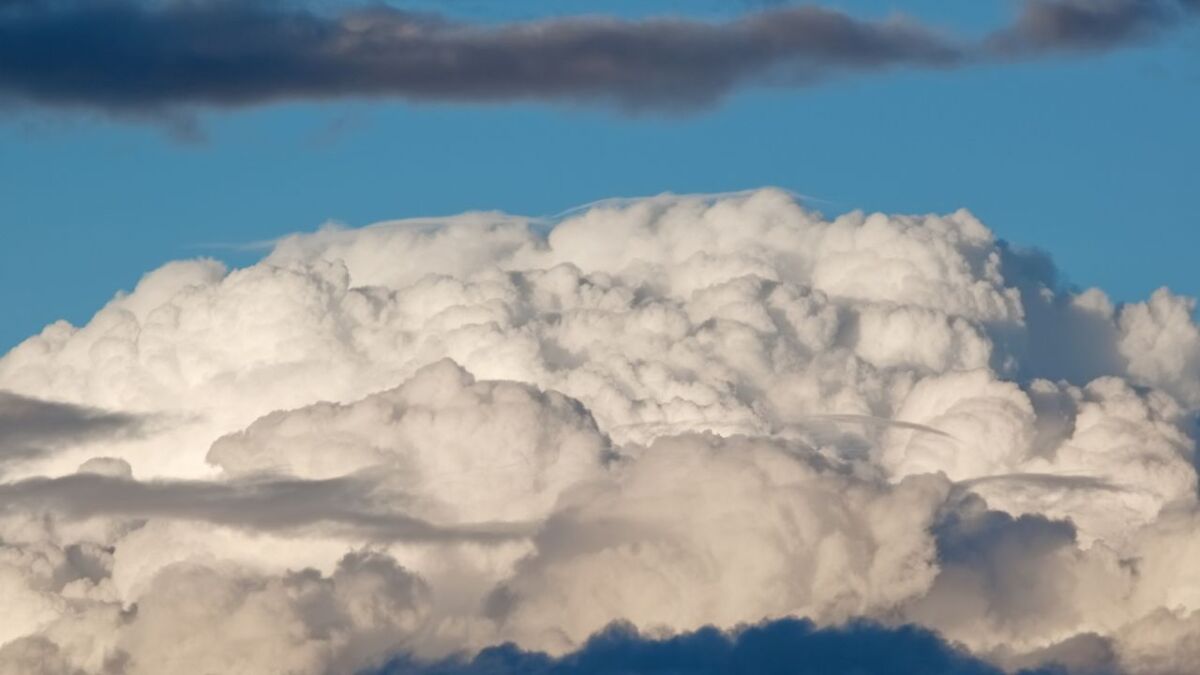 |
Cumulus: These clouds are like friendly faces in the sky - fluffy, white, and often isolated. They form on beautiful days when the sun warms the earth and air masses rise. | Usually indicates good weather. |
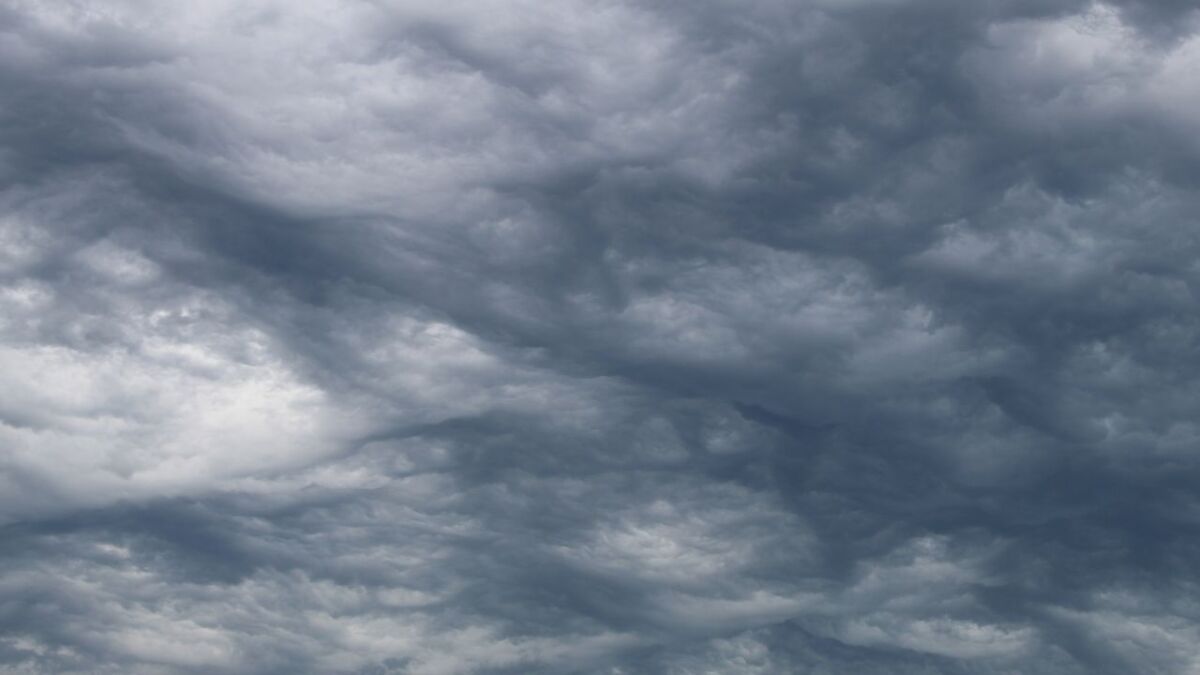 |
Stratus: A uniform, often gray cloud cover that blankets the sky characterizes stratus clouds. They are low-hanging and usually bring a solid overcast. When you see these clouds, please keep in mind your rain jacket. | Indicate drizzle or light rain. |
 |
Cirrus: These high, thin cloud threads that resemble feathers in the sky are usually white and occur at high altitudes. If you notice them, it could mean that the weather will change in the following days. | Can also be the first signs of an approaching front. |
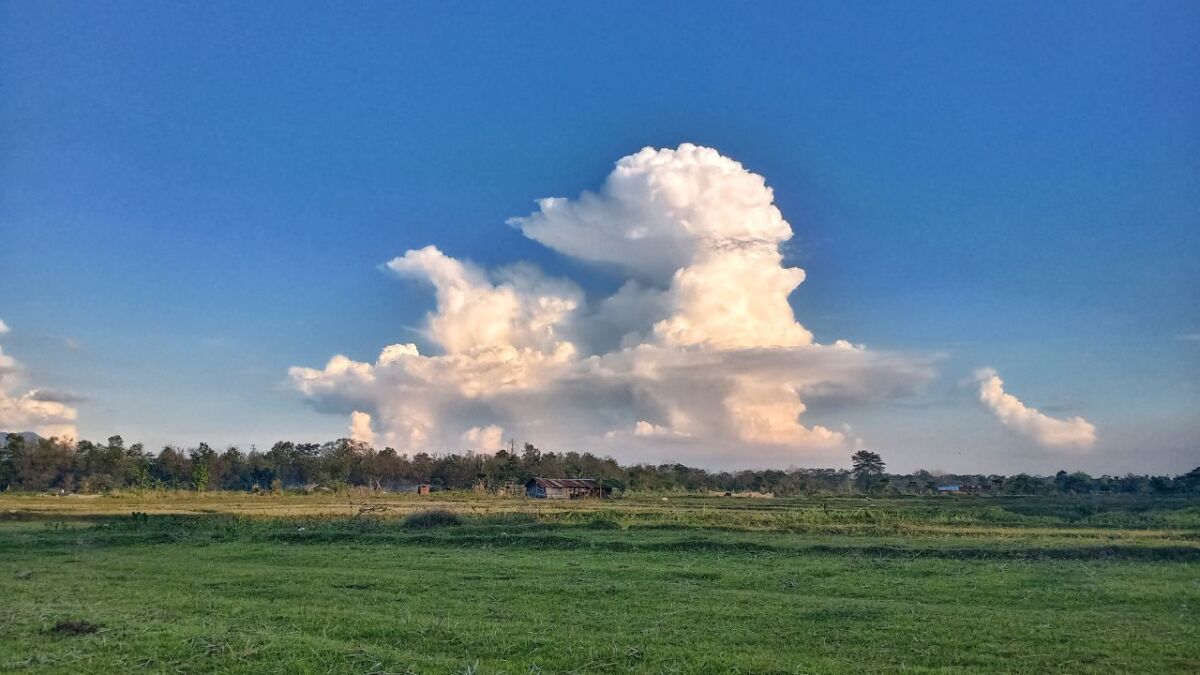 |
Cumulonimbus: These massive, often menacing clouds range from low to very high altitudes. They are the unmistakable signs that it is time to seek shelter and waterproof the tent. | Bring heavy rain showers, thunderstorms, even hail. |
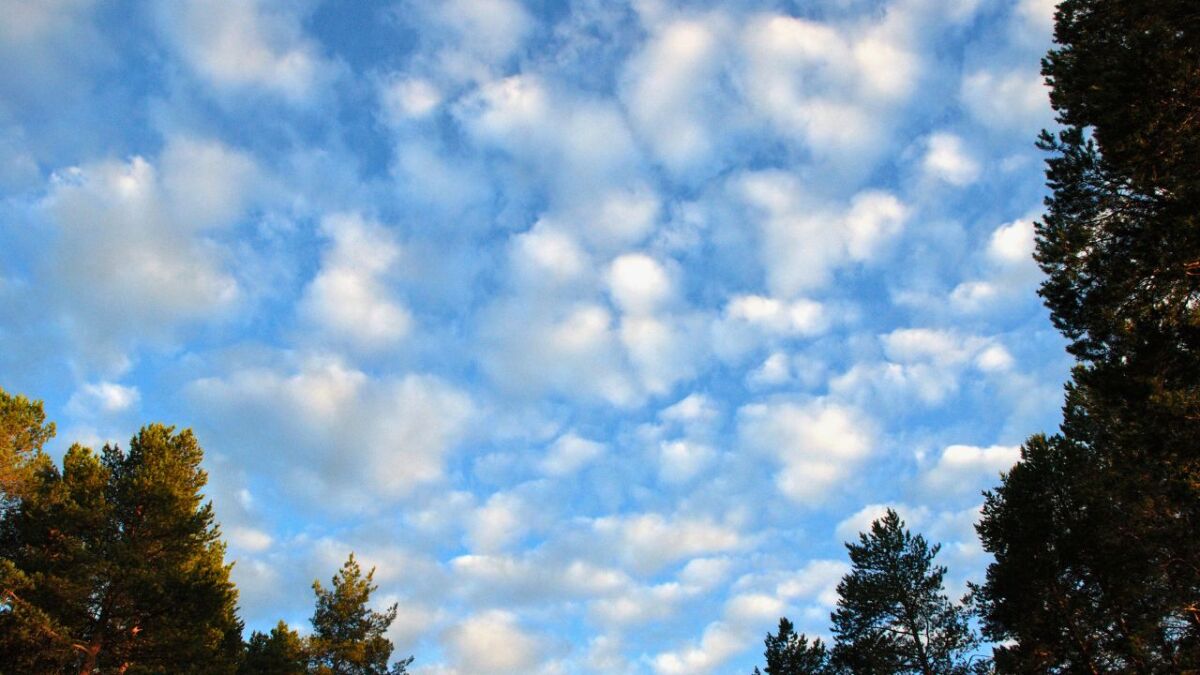 |
Altocumulus: These clouds are smaller, fluffy masses or layers that are higher than cumulus clouds. If they appear on a warm, humid morning, they can indicate thunderstorms later in the day. | Can indicate thunderstorms. |
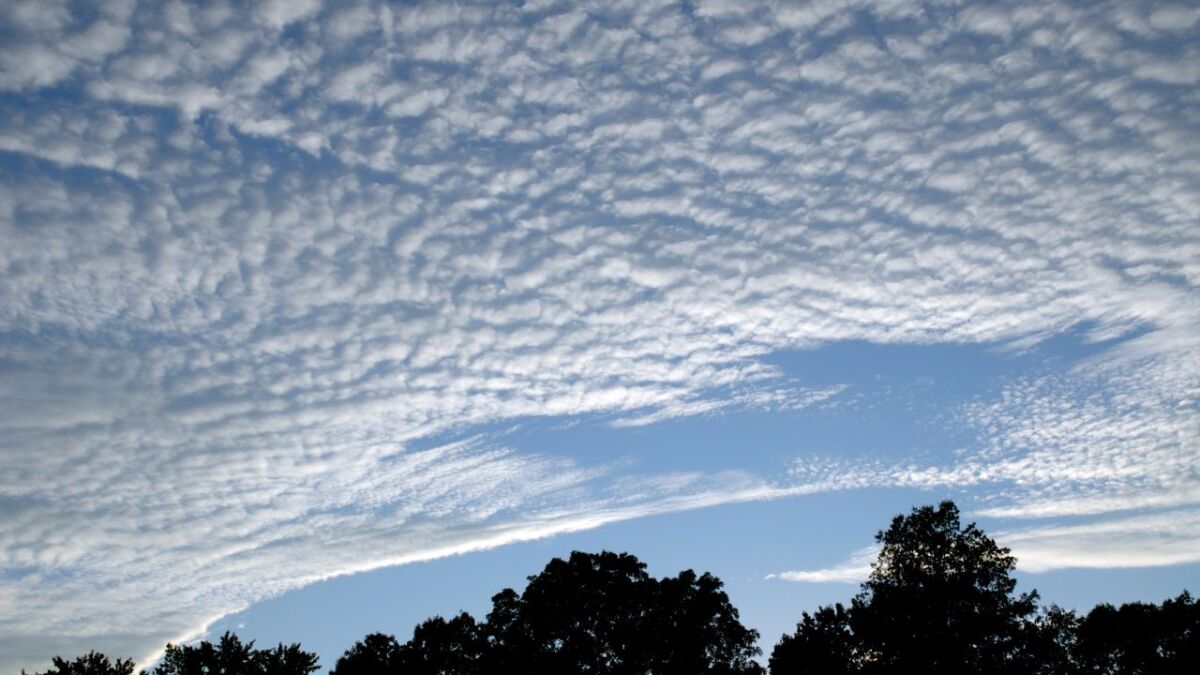 |
Altostratus: These clouds form a gray to bluish-colored blanket that often covers the entire sky. |
Usually indicate rain or snow in the next 24 hours. |
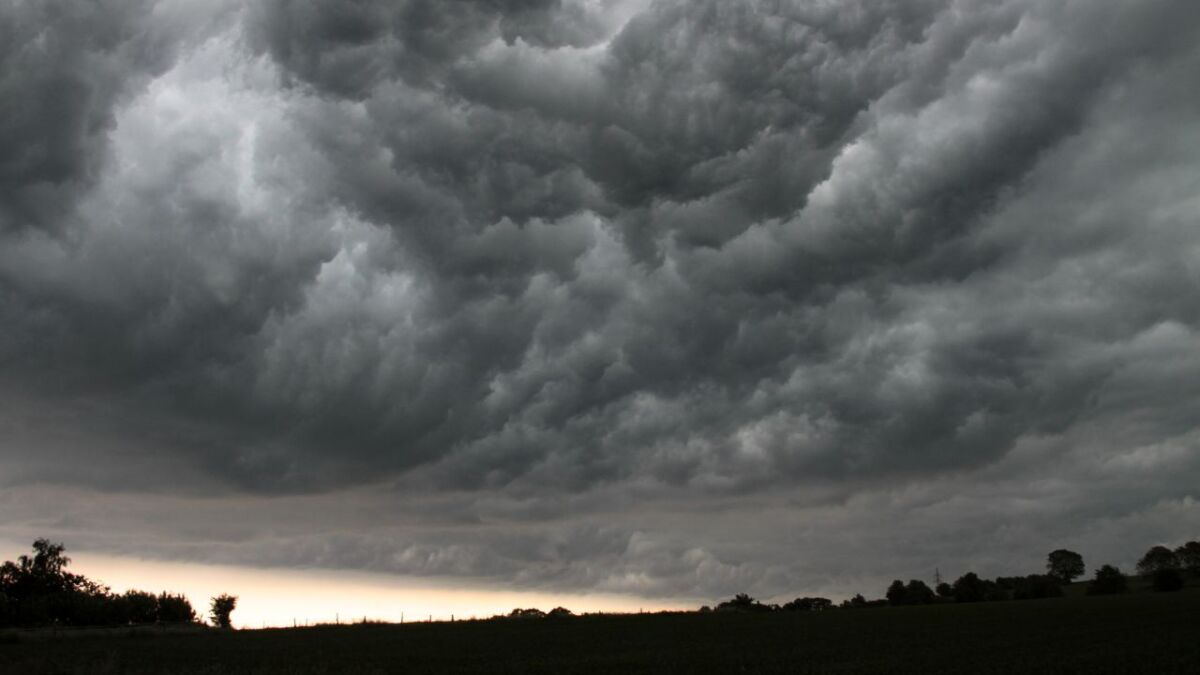 |
Nimbostratus: Denser, darker clouds that form a thick layer and bring continuous rain or snow. They often completely block the sun. | Bring rain, snow, cloudy weather. |
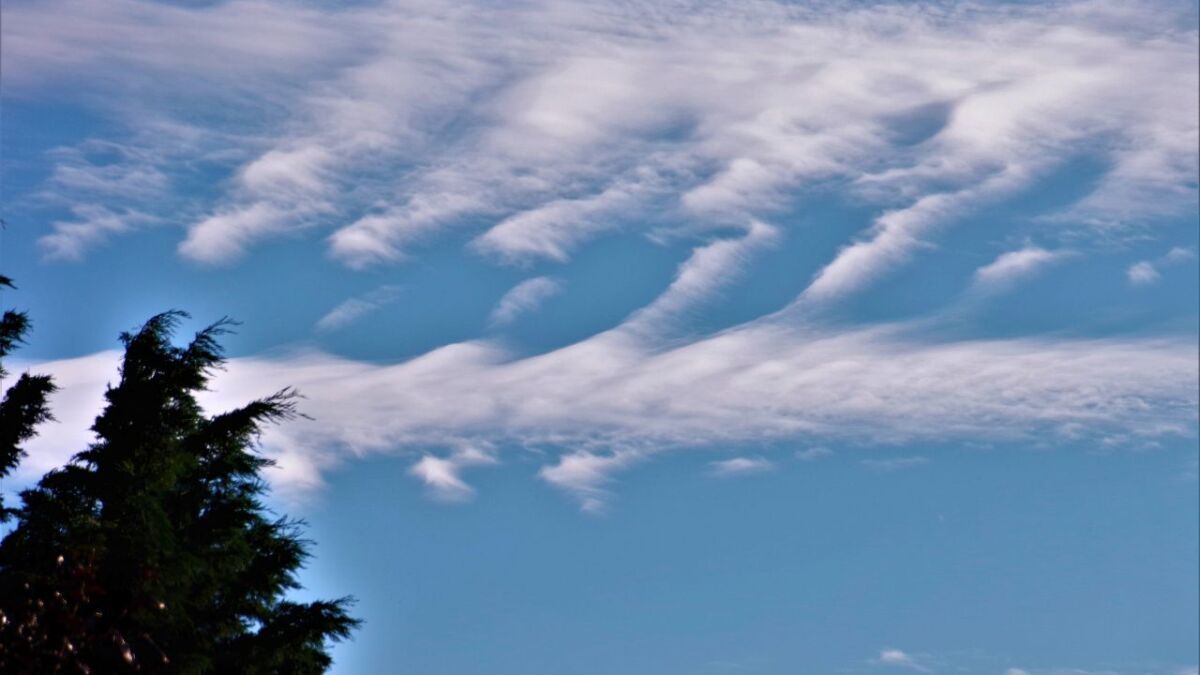 |
Kelvin-Helmholtz clouds: These rare, wave-like clouds resemble ocean waves and form when two layers of airflow past each other at different speeds or directions. | They are often a sign of turbulence in the atmosphere. |
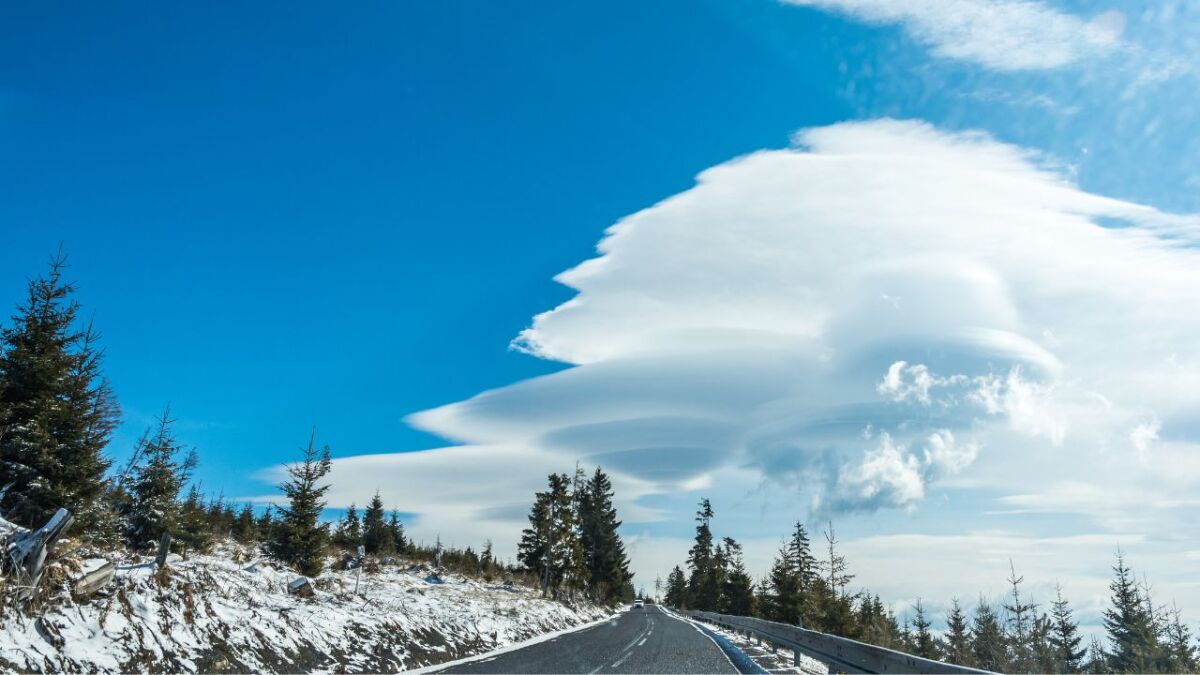 |
Lenticularis (lenticular) clouds: These clouds have the shape of lenses or UFOs and often form on the windward side of mountains. | They are a sign of strong winds in the upper layers of the atmosphere. |
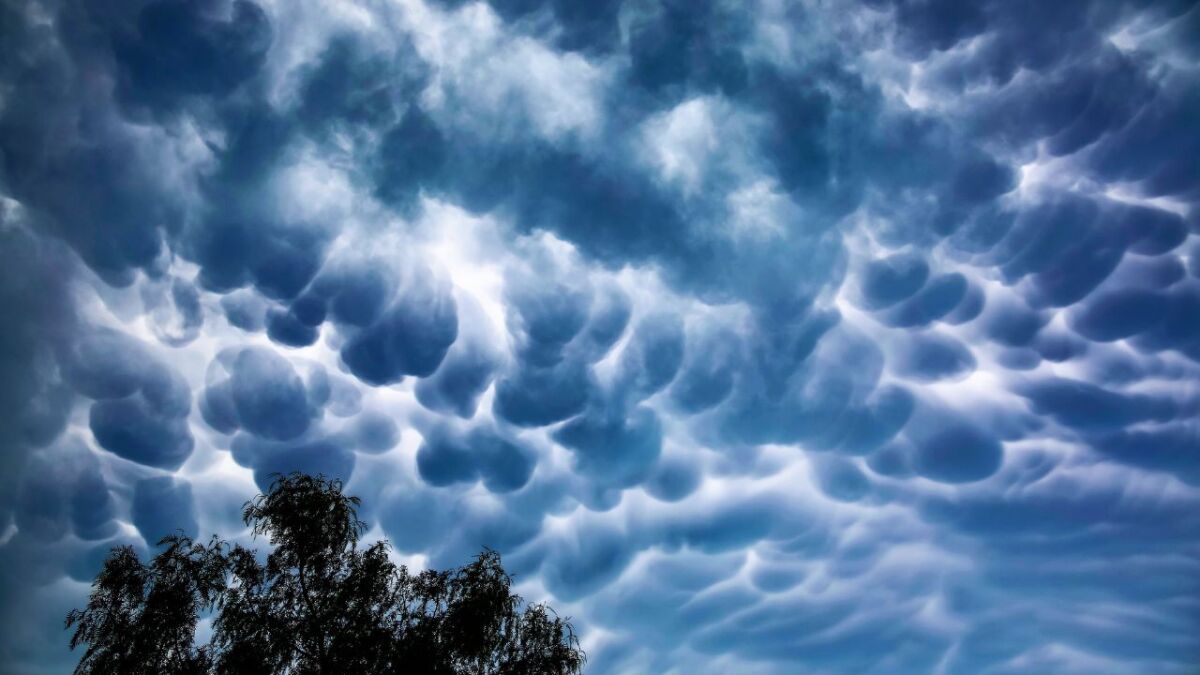 |
Mammatus: These pouch-like bulges often hang from the underside of cumulonimbus clouds and can be observed after a thunderstorm. |
They are an indication of very strong turbulence within the cloud. |
Meaning of Cloud Words
Many of the terms for cloud formations come from Latin. They were chosen to describe the characteristics or appearance of the clouds. Here are the meanings of some of these words:
- Cumulus: "Heap" or "accumulation", referring to the typical fluffy and piled appearance of this type of cloud.
- Stratus: "Layer" or "blanket", describing the uniform, layered distribution of these clouds in the sky.
- Cirrus: "Lock" or "curl", reflecting the feathery, fibrous appearance of these high clouds.
- Nimbus: "Rain cloud", referring to clouds that produce precipitation.
- Alto: A prefix meaning "high", but used in meteorology for clouds at medium altitudes (e.g., Altocumulus, Altostratus).
- Nimbostratus: A combination of "Nimbus" and "Stratus", indicating a broad, rain-producing layer cloud.
- Cumulonimbus: A combination of "Cumulus" and "Nimbus", meaning a tall, powerful cloud that extends from low to high altitudes and can generate severe thunderstorms.
- Lenticularis: "Lens-shaped", describing the typical shape of these clouds, which resemble lenses or UFOs.
- Mammatus: Derived from "Mamma" (Latin for "breast"), describing the pouch-like protrusions hanging from the underside of some clouds.
Interpreting clouds is a fascinating field. Every shape, every color, and every movement has its meaning and tells a story about what the weather has in store for us.
By learning to read these signs, you can better prepare for what's to come and adjust your plans accordingly.
5. Animal Weather Forecasters - Tree Frog, Spider, and Swallow
Animals are the intuitive meteorologists of nature. A bird chirping in a restless manner could tell you that bad weather is approaching. The relaxed humming of a bee often promises sunny outlooks.

Find access to this ancient knowledge, observe the behavior of animals - they are living barometers that miss nothing.
| Animal | Behavior | Predicts |
|---|---|---|
| Swallows | Low flight, as insects fly lower | Signals rain |
| Seagulls | Head towards the mainland | Possibly bad weather |
| Frogs | Loud croaking | Often approaching rain, due to drop in air pressure |
| Cats | Intensive grooming behind the ears | Approaching rain (debated) |
| Dogs | Restless behavior | Approaching earthquake or thunderstorm |
| Cows | Seek shelter and lay down to stay dry | Severe weather, rain |
| Ants | Build higher anthills | Approaching wet weather (different reasons) |
| Bees | Return to the hive faster, reduced activity to protect themselves | Rain is approaching |
| Spiders | No web in the morning | Possible rain (also other reasons possible) |
| Butterflies | Seek shelter, flight ability is affected by bad weather | Approaching bad weather |
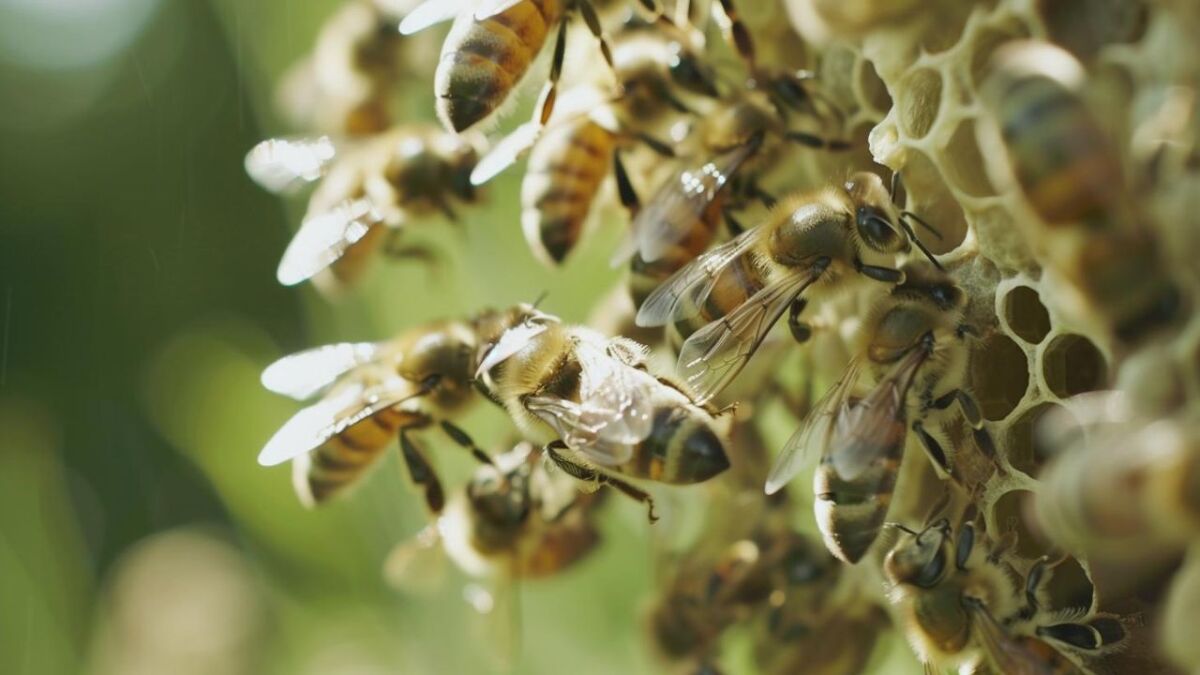
Note: Please note that the behavior of animals is not always clearly interpretable and is influenced by various factors. There is still much research needed on the topic of animals as weather forecasters.
6. Plants as Weather Prophets - Silver Thistle, Marigold, and Daisy
Plants are also sensitive indicators of weather changes. A closed mullein indicates that rain may be on the way, while a blooming dandelion suggests sunny hours.
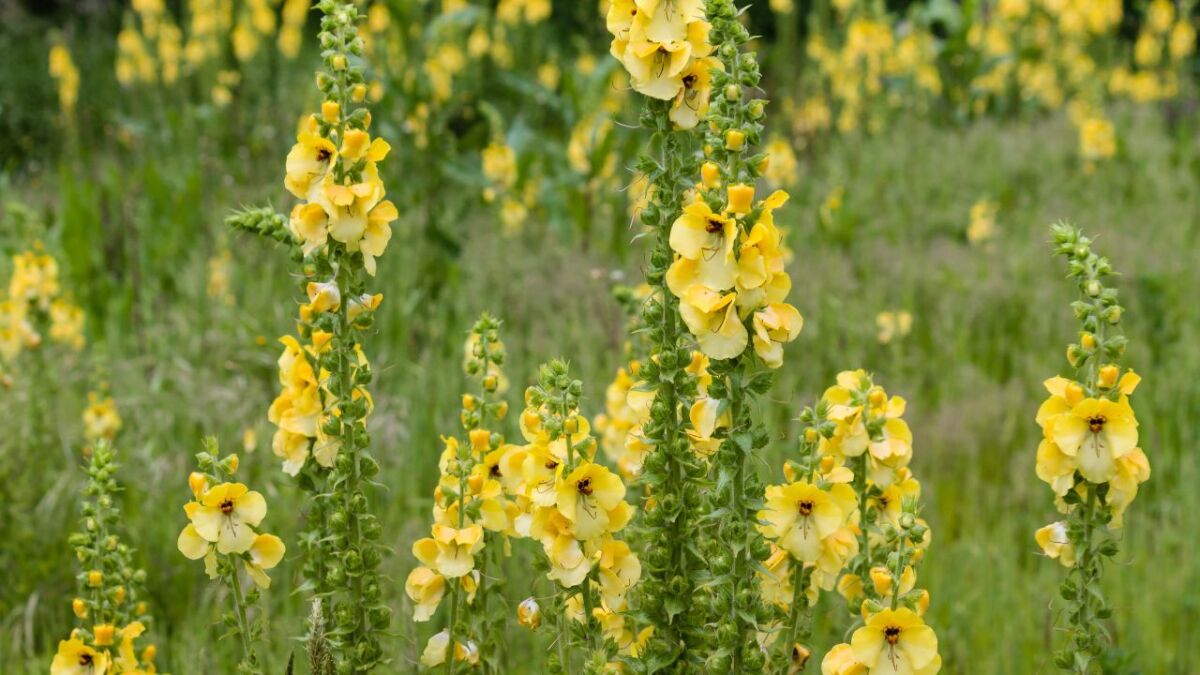
Every plant is like a small weather station - natural and freely accessible.
| Plant | Scientific Name | Behavior | Predicts |
|---|---|---|---|
| Marigold | Calendula officinalis | Closes its flowers earlier in the evening than usual | Rain |
| Mullein | Verbascum spp. | Closing flowers | Bad weather |
| Carline Thistle | Carlina acaulis | Closing flowers in increased humidity | Increased humidity |
| Dandelion | Taraxacum officinale | Closed flowers | Rain probability |
| Daisy | Bellis perennis | Closes flowers in wet and cold weather | Wet and cold weather |
| Yarrow | Achillea millefolium | Leaves roll up in dry conditions | Approaching dryness |
| Poppy | Papaver rhoeas | Closes petals in cloudy weather or rain | Cloudy weather or rain |
| Avens | Geum urbanum | Flowers close in damp weather | Damp weather |
| Tulips | Tulipa spp. | React to temperature changes | Temperature changes |
| Geranium | Pelargonium spp. | Leaves can turn red in extreme weather (strong sun or cold) | Extreme weather (strong sun or cold) |
| Fern | Tracheophyta spp. | Rolls up leaves/fronds in low humidity | Reduction of water loss |
| Quaking Grass | Briza media | Responds to slightest air movement | Wind |
| Willow | Salix spp. | Leaves droop before a storm | Storm, possibly due to humidity |
| Oak | Quercus spp. | Still has dew drops in the early morning | Stable weather (debated) |

By recognizing and interpreting these symbols correctly, you can get an idea of what the weather has in store for you. Every little detail contributes to understanding the big picture.
Take the time to observe and learn from the reactions of animals and plants. They have been here for millennia and have perfected their wisdom - we just need to be willing to listen.
Read more about the plants in detail here:
- Survival artist dandelion - weed? No! The dandelion is a survival and medicinal plant
- The common yarrow: secret weapon for wilderness living
- 6 trees every survivalist should know
Respectful Handling of the Natural Barometer
Your observations tell you how nature reacts to the smallest changes in weather. Note them carefully and soon, yes soon, you will be far ahead of the weather satellite.
Because those who communicate directly with nature recognize rain, wind, and sunshine before they appear in the sky.
While reading the signs of nature, we must not forget to treat it with respect. We are guests in its realm, and it is our duty to leave it untouched.
By understanding the signs that nature gives us, we become true nature detectives.
This is not witchcraft, but a combination of attention, knowledge, and mindfulness.
Believe me, with every cloud, every animal, and every plant that you learn to interpret, your respect for nature grows - and your confidence in your abilities.

Your Logbook of the Skies: The Weather Diary
The weather diary becomes your daily ritual. Every day you capture sky images, note clouds, colors and shapes, follow the wind, and record what the flora and fauna whisper to you.
Soon you will recognize patterns - your natural understanding of the weather is growing!
Your checklist for the perfect weather diary
- Date and Time: Each entry should be timestamped accurately.
- Temperature: Note the perceived and actual temperature, if possible.
- Cloud Formations: Record the shapes and movements of the clouds.
- Wind Direction and Strength: Describe the direction and strength of the wind.
- Precipitation: Note if and how intensely it is raining, snowing, or hailing.
- Air Pressure: If you have a barometer, record the air pressure.
- Humidity: Estimate how humid the air feels - is it dry, moist, or muggy?
- Animal Behavior: Observe animals and note any notable behaviors.
- Plant Reactions: Describe how plants react to the weather - such as closed blossoms.
- Personal Remarks: Add your feelings or special observations.
Equipped with this checklist, your weather diary becomes a precise instrument that allows you to make your own forecasts and continuously strengthen your skills in reading natural weather.

How-to Guide: Building a Natural Weather Station in 10 Steps
With your own weather station, you can accurately capture current weather trends and changes.
By following this guide and with a little patience, you will learn to predict the weather like an experienced naturalist.
Your station will become more accurate over time as you learn more about the natural signs and incorporate them into your daily notes.
Weather forecasts and their limitations: unfortunately not always reliable
Now that we have mastered the traditional weather forecast, we also need to recognize the downsides - not everything is predictable.
Understanding the Whispers of Nature
👉 Yes, we can learn to interpret the signs that the weather sends us, but nature has its secrets. Sometimes its hints are whispered and difficult to interpret. What may seem like a clear message can be deceptive. Animals can change their routines, and cloud formations are not always definitive messengers.
Questioning the Reliability of Natural Signs
👉 Sure, the behavior of ants or the closing of flowers can indicate rain, but it's not a guarantee. Nature signs are useful indicators, but they are not infallible. I have learned to trust them, but also to be cautious and follow my instincts.
Climate Change and its Effects
👉 Climate change is reshuffling the deck. Old wisdom may lose its validity as weather phenomena become more extreme and less predictable. It becomes even more important to stay flexible and be willing to adapt one's own knowledge.
Risks when navigating the unpredictable nature
I know that despite all my skills, I can't always stay one step ahead of the elements. The weather can change, and I have to be ready to change my plans - safety always comes first.
Recognizing these boundaries and yet utilizing the knowledge of the old masters and one's own intuition teaches us humility towards nature.
And if we respect that she has the final word, then we will become wiser, more mindful, and ready to face the challenges that she has in store for us.
Stay on the ball: Resources for continuous learning
You have mastered the basics, but the world of weather reading is vast. Here is your treasure map to continuous learning.
Refine your skills
Now that your interest in deciphering the sky has been awakened, take every opportunity to learn more. Attend workshops, follow weather forums, and engage with like-minded individuals. Every day can be a lesson.
Digital assistants as support
Our ancestors may not have had smartphones, but that doesn't mean we shouldn't use them. Weather forecast apps can be a valuable addition to check and expand your knowledge of nature.
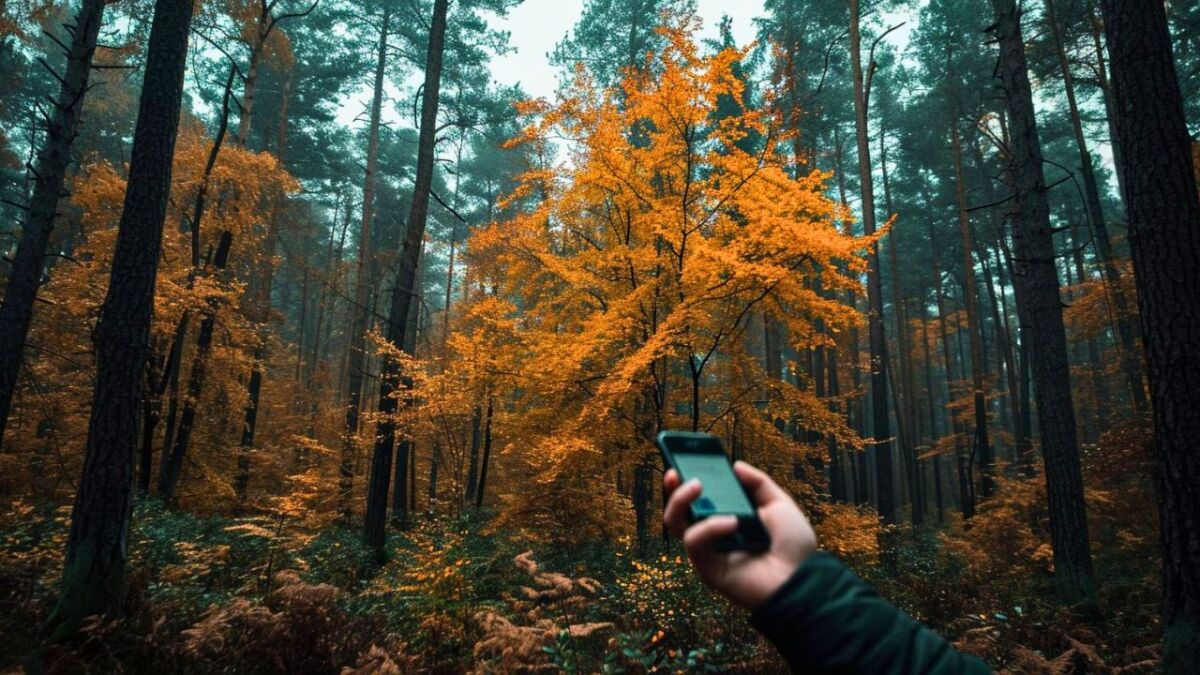
Connect with the Community
There are numerous forums and groups where outdoor enthusiasts like you share their knowledge. Become part of this community. It's wonderful how much you can learn from the experiences of others.
Science meets nature
If your hunger for knowledge has not been satisfied yet, universities and online courses offer deeper insights into the science of weather. Combine traditional techniques with modern meteorology to take your understanding to the next level.
Nature as part of education
Also consider sharing your knowledge in wilderness education. Share your experiences with others, teach the art of weather reading, and become a nature ambassador yourself.
The goal is to never stop being curious and constantly expand your knowledge. The weather and its patterns are an infinite book - and you have just begun to discover its pages.
Dive deeper and you will learn to understand the language of the heavens, whether with or without technical gadgets.
Conclusion: Your compass in the world of weather messengers
The journey may be long, but now you possess the compass to navigate through the vast sea of weather forecasts.
In summary, you have a powerful repertoire of knowledge and techniques at your disposal to interpret the signs of nature.
Bundle the treasures
Pause and look back on what you have learned. From cloud reading to animals and plants as weather indicators - you can now better feel and understand the rhythms of nature.
Use the guide here as a checklist that you can always carry with you to not forget the most important points (you can also download and save it as a PDF below).
Now it's up to you to take the steps and apply your knowledge. Practice makes perfect in reading the sky. Start with small hikes, observe and learn. Soon you will become someone who is not surprised, but surprises.
Now it's your turn
Your opinion is important to us, and we appreciate it when you share it with us. Every insight expands our community and helps us all delve deeper into understanding the weather.
In this sense: keep your gaze firmly directed upwards, your senses sharpened, and your curiosity always burning - nature still has so many secrets to share, and you have only just begun to discover them.

Sources for the guide
https://weather.com/de-DE/wissen/tiere/news/2023-01-28-die-vorhersage-fahigkeiten-von-tierischen-wetterboten

Author of the guide
Martin Gebhardt
Hey, I'm Martin. On my blog, you will learn the basics and numerous details about living in the wild. I think survival, bushcraft and the good life in nature are the keys to happiness. Find me here on Instagram or on YouTube. You can find more about my mission on the About Me page.
Was this guide helpful?
42 people found this guide helpful.
5.00 out of 5 points (42 Ratings)
Comments (0)
This post may contain affiliate links. So if you click on the links and make a purchase, I will receive a small commission at no additional cost to you. Click here, to learn more about it.


